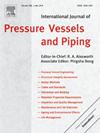Material selection of titanium alloy pipelines considering multi-criteria in an acidic environment based on analytic hierarchy process
IF 3
2区 工程技术
Q2 ENGINEERING, MECHANICAL
International Journal of Pressure Vessels and Piping
Pub Date : 2025-02-10
DOI:10.1016/j.ijpvp.2025.105461
引用次数: 0
Abstract
In the construction of offshore oil and gas projects, the selection of pipeline materials is significant and challenging. In the complex marine environment, it is difficult to ensure the safe service life of oil and gas pipelines selected only based on the consideration of the corrosion resistance of materials. Therefore, multiple performance indicators should be comprehensively considered in the material selection. The partial pressure of H2S and CO2 in the oil and gas of an offshore block was as high as 2 MPa and the temperature of the transported fluid was up to 70 °C. Rock particles were carried in the fluid. In this study, TA3, TA10, and TA36 titanium alloy materials to be used in this block were evaluated through various tests, including physical and chemical tests (tensile test, impact test, bending test, and hardness test), friction wear test, gas-solid erosion test, corrosion test, and corrosion wear test. In this paper, based on the consideration of the performance indicators and expert knowledge corresponding to the above tests, a material selection method based on analytic hierarchy process was proposed and the priority in the material selection of marine pipelines was studied. In addition, the microstructures and element distributions of the tensile and impact fractures, erosion pits, and friction traces of the materials were studied by a scanning electron microscope, an energy dispersive spectroscope, and a laser confocal microscope. The results of hierarchical analysis showed that the selection priority of TA3, TA10, and TA36 titanium alloys was TA10 < TA3 < TA36. TA36 titanium alloy was the best material choice for the submarine pipeline system in the target area and the corresponding weight was 0.60121. The results provided the basis for the selection of the best material alternative for the construction of submarine pipelines in this block.

基于层次分析法的酸性环境下多准则钛合金管道选材
在海洋油气工程建设中,管道材料的选择是一项重要且具有挑战性的工作。在复杂的海洋环境中,仅根据材料的耐腐蚀性来选择油气管道,很难保证其安全使用寿命。因此,在选材时应综合考虑多种性能指标。某海上区块油气中H2S和CO2的分压高达2 MPa,输送流体温度高达70℃。岩石颗粒在流体中被携带。本研究对该砌块使用的TA3、TA10、TA36钛合金材料进行了理化试验(拉伸试验、冲击试验、弯曲试验、硬度试验)、摩擦磨损试验、气固冲蚀试验、腐蚀试验、腐蚀磨损试验等。本文在综合考虑上述试验所对应的性能指标和专家知识的基础上,提出了一种基于层次分析法的材料选择方法,并对海洋管道材料选择的优先级进行了研究。利用扫描电子显微镜、能量色散光谱仪和激光共聚焦显微镜研究了材料的拉伸、冲击断裂、侵蚀坑和摩擦痕迹的显微组织和元素分布。分层分析结果表明,TA3、TA10和TA36钛合金的优先选择顺序为TA10 <;TA3 & lt;TA36。TA36钛合金是目标区域海底管道系统的最佳材料选择,其重量为0.60121。研究结果为该区块海底管道施工材料选择提供了依据。
本文章由计算机程序翻译,如有差异,请以英文原文为准。
求助全文
约1分钟内获得全文
求助全文
来源期刊
CiteScore
5.30
自引率
13.30%
发文量
208
审稿时长
17 months
期刊介绍:
Pressure vessel engineering technology is of importance in many branches of industry. This journal publishes the latest research results and related information on all its associated aspects, with particular emphasis on the structural integrity assessment, maintenance and life extension of pressurised process engineering plants.
The anticipated coverage of the International Journal of Pressure Vessels and Piping ranges from simple mass-produced pressure vessels to large custom-built vessels and tanks. Pressure vessels technology is a developing field, and contributions on the following topics will therefore be welcome:
• Pressure vessel engineering
• Structural integrity assessment
• Design methods
• Codes and standards
• Fabrication and welding
• Materials properties requirements
• Inspection and quality management
• Maintenance and life extension
• Ageing and environmental effects
• Life management
Of particular importance are papers covering aspects of significant practical application which could lead to major improvements in economy, reliability and useful life. While most accepted papers represent the results of original applied research, critical reviews of topical interest by world-leading experts will also appear from time to time.
International Journal of Pressure Vessels and Piping is indispensable reading for engineering professionals involved in the energy, petrochemicals, process plant, transport, aerospace and related industries; for manufacturers of pressure vessels and ancillary equipment; and for academics pursuing research in these areas.

 求助内容:
求助内容: 应助结果提醒方式:
应助结果提醒方式:


